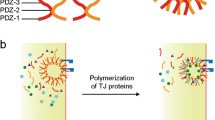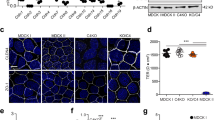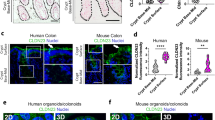Abstract
Belt-like tight junctions (TJs), referred to as zonula occludens, have long been regarded as a specialized differentiation of epithelial cell membranes. They are required for cell adhesion and paracellular barrier functions, and are now thought to be partly involved in fence functions and in cell polarization. Recently, the molecular bases of TJs have gradually been unveiled. TJs are constructed by TJ strands, whose basic frameworks are composed of integral membrane proteins with four transmembrane domains, designated claudins. The claudin family is supposedly composed of at least 24 members in mice and humans. Other types of integral membrane proteins with four transmembrane domains, namely occludin and tricellulin, as well as the single transmembrane proteins, JAMs (junctional adhesion molecules) and CAR (coxsackie and adenovirus receptor), are associated with TJ strands, and the high-level organization of TJ strands is likely to be established by membrane-anchored scaffolding proteins, such as ZO-1/2. Recent functional analyses of claudins in cell cultures and in mice have suggested that claudin-based TJs may have pivotal functions in the regulation of the epithelial microenvironment, which is critical for various biological functions such as control of cell proliferation. These represent the dawn of ‘Barriology’ (defined by Shoichiro Tsukita as the science of barriers in multicellular organisms). Taken together with recent reports regarding changes in claudin expression levels, understanding the regulation of the TJ-based microenvironment system will provide new insights into the regulation of polarization in the respect of epithelial microenvironment system and new viewpoints for developing anticancer strategies.
This is a preview of subscription content, access via your institution
Access options
Subscribe to this journal
Receive 50 print issues and online access
$259.00 per year
only $5.18 per issue
Buy this article
- Purchase on Springer Link
- Instant access to full article PDF
Prices may be subject to local taxes which are calculated during checkout




Similar content being viewed by others
References
Amieva MR, Vogelmann R, Covacci A, Tompkins LS, Nelson WJ, Falkow S . (2003). Disruption of the epithelial apicaljunctional complex by Helicobacter pylori CagA. Science 300: 1430–1434.
Angelow S, Ahlstrom R, Yu AS . (2008). Biology of claudins. Am J Physiol Renal Physiol (in press).
Behr M, Riedel D, Schuh R . (2003). The Claudin-like megatrachea is essential in septate junctions for the epithelial barrier function in Drosophila. Dev Cell 5: 611–620.
Ben-Yosef T, Belyantseva IA, Saunders TL, Hughes ED, Kawamoto K, Van Itallie CM et al. (2003). Claudin 14 knockout mice, a model for autosomal recessive deafness DFNB29, are deaf due to cochlear hair cell degeneration. Hum Mol Genet 12: 2049–2061.
Chao JC, Liu KY, Chen SH, Fang CL, Tsao CW . (2003). Effect of oral Epidermal growth factor on mucosal healing in rats with duodenal ulcer. World J Gastroenterol 9: 2261–2265.
Claude P . (1978). Morphological factors influencing transepithelial permeability: a model for the resistance of the zonula occludens. J Membr Biol 39: 219–232.
Cohen CJ, Shieh JT, Pickles RJ, Okegawa T, Hsieh JT, Bergelson JM . (2001). The coxsackie virus and adenovirus receptor is a transmembrane component of the tight junction. Proc Natl Acad Sci USA 98: 15191–15196.
Colegio OR, Van Itallie C, Rahner C, Anderson JM . (2003). Claudin extracellular domains determine paracellular charge selectivity and resistance but not tight junction fibril architecture. Am J Physiol Cell Physiol 284: 1346–1354.
Diamond JM . (1977). Twenty-first Bowditch lecture. The epithelial junction: bridge, gate, and fence. Physiologist 20: 10–18.
D’Souza T, Indig FE, Morin PJ . (2007). Phosphorylation of claudin-4 by PKCepsilon regulates tight junction barrier function in ovarian cancer cells. Exp Cell Res 313: 3364–3375.
Farquhar MG, Palade GE . (1963). Junctional complexes in various epithelia. J Cell Biol 17: 375–412.
Frizzell RA, Schultz SG . (1972). Ionic conductances of extracellular shunt pathway in rabbit ileum: influence of shunt on transmural sodium transport and electrical potential differences. J Gen Physiol 59: 318–346.
Fujita K, Katahira J, Horiguchi Y, Sonoda N, Furuse M, Tsukita Sh . (2000). Clostridium perfringens enterotoxin binds to the second extracellular loop of claudin-3, a tight junction integral membrane protein. FEBS Lett 476: 258–261.
Furuse M, Furuse K, Sasaki H, Tsukita Sh . (2001). Conversion of zonulae occludentes from tight to leaky strand type by introducing claudin-2 into Madin-Darby canine kidney I cells. J Cell Biol 153: 263–272.
Furuse M, Hata M, Furuse K, Yoshida Y, Haratake A, Sugitani Y et al. (2002). Claudin-based tight junctions are crucial for the mammalian epidermal barrier: a lesson from claudin-1-deficient mice. J Cell Biol 156: 1099–1111.
Furuse M, Hirase T, Itoh M, Nagafuchi A, Yonemura S, Tsukita Sa et al. (1993). Occludin: a novel integral membrane protein localizing at tight junctions. J Cell Biol 123: 1777–1788.
Furuse M, Sasaki H, Tsukita Sh . (1999). Manner of interaction of Heterogeneous claudin species within and between tight junction strands. J Cell Biol 147: 891–903.
González-Mariscal L, Lechuga S, Garay E . (2007). Role of tight junctions in cell proliferation and cancer. Prog Histochem Cytochem 42: 1–57.
Gow A, Southwood CM, Li JS, Pariali M, Riordan GP, Brodie SE et al. (1999). CNS myelin and Sertoli cell tight junction strands are absent in Osp/Claudin-11 null mice. Cell 99: 649–659.
Gumbiner BM . (1993). Breaking through the tight junction barrier. J Cell Biol 123: 1631–1633.
Hamazaki Y, Itoh M, Sasaki H, Furuse M, Tsukita Sh . (2002). Multi-PDZ domain protein 1 (MUPP1) is concentrated at tight junctions through its possible interaction with claudin-1 and junctional adhesion molecule. J Biol Chem 277: 455–461.
Hartsock A, Nelson WJ . (2008). Adherens and tight junctions: structure, function and connections to the actin cytoskeleton. Biochim Biophys Acta 1778: 660–669.
Hopfer U . (1977). Isolated membrane vesicles as tools for analysis of epithelial transport. Am J Physiol 233: E445–E449.
Hou J, Gomes AS, Paul DL, Goodenough DA . (2006). Study of claudin function by RNA interference. J Biol Chem 281: 36117–36123.
Ikenouchi J, Matsuda M, Furuse M, Tsukita Sh . (2003). Regulation of tight junctions during the epithelium-mesenchyme transition: direct repression of the gene expression of claudins/occludin by Snail. J Cell Sci 116: 1959–1967.
Ikenouchi J, Furuse M, Furuse K, Sasaki H, Tsukita Sa, Tsukita Sh . (2005). Tricellulin constitutes a novel barrier at tricellular contacts of epithelial cells. J Cell Biol 171: 939–945.
Itoh M, Furuse M, Morita K, Kubota K, Saitou M, Tsukita Sh . (1999). Direct binding of three tight junction-associated MAGUKs, ZO-1, ZO-2, and ZO-3, with the COOH termini of claudins. J Cell Biol 147: 1351–1363.
Itoh M, Sasaki H, Furuse M, Ozaki H, Kita T, Tsukita Sh . (2001). Junctional adhesion molecule (JAM) binds to PAR-3: a possible mechanism for the recruitment of PAR-3 to tight junctions. J Cell Biol 154: 491–497.
Katahira J, Inoue N, Horiguchi Y, Matsuda M, Sugimoto N . (1997). Molecular cloning and functional characterization of the receptor for Clostridium perfringens enterotoxin. J Cell Biol 136: 1239–1247.
Katsuno T, Umeda K, Matsui T, Hata M, Tamura A, Itoh M et al. (2008). Deficiency of zonula occludens-1 causes embryonic lethal phenotype associated with defected yolk sac angiogenesis and apoptosis of embryonic cells. Mol Biol Cell 19: 2465–2475.
Kachar B, Reese TS . (1982). Evidence for the lipidic nature of tight junction strands. Nature 296: 464–466.
Kitajiri S, Miyamoto T, Mineharu A, Sonoda N, Furuse K, Hata M et al. (2004). Compartmentalization established by claudin-11-based tight junctions in stria vascularis is required for hearing through generation of endocochlear potential. J Cell Sci 117: 5087–5096.
Kominsky SL . (2006). Claudins: emerging targets for cancer therapy. Expert Rev Mol Med 8: 1–11.
Konrad M, Schaller A, Seelow D, Pandey AV, Waldegger S, Lesslauer A et al. (2006). Mutations in the tight-junction gene claudin 19 (CLDN19) are associated with renal magnesium wasting, renal failure, and severe ocular involvement. Am J Hum Genet 79: 949–957.
Kottra G, Haase W, Frömter E . (1993a). Tight-junction tightness of Necturus gall bladder epithelium is not regulated by cAMP or intracellular Ca2+. I. Microscopic and general electrophysiological observations. Pflugers Arch 425: 528–534.
Kottra G, Frömter E . (1993b). Tight-junction tightness of Necturus gall bladder epithelium is not regulated by cAMP or intracellular Ca2+. II. Impedance measurements. Pflugers Arch 425: 535–545.
Krause G, Winker L, Mueller SL, Haseloff RF, Piontek J, Blasig IE . (2008). Structure and function of claudins. Biochi Biophy Acta 1778: 631–645.
Lioni M, Brafford P, Andl C, Rustgi A, El-Deiry W, Herlyn M et al. (2007). Dysregulation of claudin-7 leads to loss of E-cadherin expression and the increased invasion of esophageal squamous cell carcinoma cells. Am J Pathol 170: 709–721.
Liu Y, Nursat A, Schnell FJ, Reaves TA, Walsh S, Pochet M et al. (2000). Human junction adhesion molecule regulates tight junction resealing in epithelia. J Cell Sci 113: 2363–2374.
Loh YH, Christoffels A, Brenner S, Hunziker W, Venkatesh B . (2004). Extensive expansion of the claudin gene family in the teleost fish, Fugu rubripes. Genome Res 14: 1248–1257.
Macarthur M, Hold GL, El-Omar EM . (2004). Inflammation and Cancer II. Role of chronic inflammation and cytokine gene polymorphisms in the pathogenesis of gastrointestinal malignancy. Am J Physiol Gastrointest Liver Physiol 286: G515–G520.
Matsuda M, Kubo A, Furuse M, Tsukita Sh . (2004). A peculiar internalization of claudins, tight junction-specific adhesion molecules, during the intercellular movement of epithelial cells. J Cell Sci 117: 1247–1257.
Mitic LL, Anderson JM . (1998). Molecular architecture of tight junctions. Annu Rev Physiol 60: 121–142.
Miyamoto T, Morita K, Takemoto D, Takeuchi K, Kitano Y, Miyakawa T et al. (2005). Tight junctions in Schwann cells of peripheral myelinated axons: a lesson from claudin-19-deficient mice. J Cell Biol 169: 527–538.
Morita K, Sasaki H, Furuse M, Tsukita Sh . (1999a). Endothelial claudin: claudin-5/TMVCF constitutes tight junction strands in endothelial cells. J Cell Biol 147: 185–194.
Morita K, Sasaki H, Fujimoto K, Furuse M, Tsukita Sh . (1999b). Claudin-11/OSP-based tight junctions of myelin sheaths in brain and Sertoli cells in testis. J Cell Biol 145: 579–588.
Morita K, Furuse M, Yoshida Y, Itoh M, Sasaki H, Tsukita Sh et al. (2002). Molecular architecture of tight junctions of periderm differs from that of the maculae occludentes of epidermis. J Invest Dermatol 118: 1073–1079.
Moriwaki K, Tsukita S, Furuse M . (2007). Tight junctions containing claudin 4 and 6 are essential for blastocyst formation in preimplantation mouse embryos. Dev Biol 312: 509–522.
Nitta T, Hata M, Gotoh S, Seo Y, Sasaki H, Hashimoto N et al. (2003). Size-selective loosening of the blood-brain barrier in claudin-5-deficient mice. J Cell Biol 161: 653–660.
Okada Y, Irimajiri A, Inouye A . (1977). Electrical properties and active Solute transport in rat intestine. II. Conductive properties of transepithelial routes. J Membr Biol 31: 221–232.
Pan XY, Wang B, Che YC, Weng ZP, Dai HY, Peng W . (2007). Expression of claudin-3 and claudin-4 in normal, hyperplastic, and endometrial tissue. Int J Gynecol Cancer 17: 233–241.
Pinto da Silva P, Kachar B . (1982). On tight junction structure. Cell 28: 441–450.
Powell DW . (1981). Barrier function of epithelia. Am J Physiol 241: 275–288.
Reuss L . (1992). Tight junction permeability to ions and water. In: Cereijido M (ed). Tight Junctions. CRC Press: London, 49–66.
Saitou M, Furuse M, Sasaki H, Schulzke JD, Fromm M, Takano H et al. (2000). Complex phenotype of mice lacking occludin, a component of tight junction strands. Mol Biol Cell 11: 4131–4142.
Sánchez-Pulido L, Mart́n-Belmonte F, Valencia A, Alonso MA . (2002). MARVEL: a conserved domain involved in membrane apposition events. Trends Biochem Sci 27: 599–601.
Sasaki H, Matsui C, Furuse K, Mimori-Kiyosue Y, Furuse M, Tsukita Sh . (2003). Dynamic behavior of paired claudin strands within apposing plasma membranes. Proc Natl Acad Sci USA 100: 3971–3976.
Schmidt A, Utepbergenov DI, Mueller SL, Beyermann M, Schneider-Mergener J, Krause G et al. (2004). Occludin binds to the SH3-hinge-GuK unit of zonula occludens protein 1: potential mechanism of tight junction regulation. Cell Mol Life Sci 61: 1354–1365.
Schultheis PJ, Clarke LL, Meneton P, Miller ML, Soleimani M, Gawenis LR et al. (1998). Renal and intestinal absorptive defects in mice lacking the NHE3 Na+/H+ exchanger. Nat Genet 19: 282–285.
Simon DB, Lu Y, Choate KA, Velazquez H, Al-Sabban E, Praga M et al. (1999). Paracellin-1, a renal tight junction protein required for paracellular Mg2+ resorption. Science 285: 103–106.
Singh AB, Harris RC . (2004). Epidermal growth factor receptor activation differentially regulates claudin expression and enhances transepithelial resistance in Madin-Darby canine kidney cells. J Biol Chem 279: 3543–3552.
Song B, Zhao M, Forrester JV, McCaig CD . (2002). Electrical cues regulate the orientation and frequency of cell division and the rate of wound healing in vivo. Proc Natl Acad Sci USA 99: 13577–13582.
Sonoda N, Furuse M, Sasaki H, Yonemura S, Katahira J, Horiguchi Y et al. (1999). Clostridium perfringens enterotoxin fragment removes specific claudins from tight junction strands: evidence for direct involvement of claudins in tight junction barrier. J Cell Biol 147: 195–204.
Staehelin LA . (1973). Further observation on the fine structure of freeze-cleaved tight junctions. J Cell Sci 13: 763–786.
Tamura A, Kitano Y, Hata M, Katsuno T, Moriwaki K, Sasaki H et al. (2008). Megaintestinein claudin-15-deficient mice. Gastroenterology 134: 523–534.
Tatum R, Zhang Y, Lu Q, Kim K, Jeansonne BG, Chen YH . (2007). WNK4 phosphorylates ser(206) of claudin-7 and promotes paracellular Cl(-) permeability. FEBS Lett 581: 3887–3891.
Toivola DM, Krishnan S, Binder HJ, Singh SK, Omary MB . (2004). Keratins modulate colonocyte electrolyte transport via protein mistargeting. J Cell Biol 164: 911–921.
Tsukita Sh, Tsukita Sa . (1989). Isolation of cell-to-cell adherens junctions from rat liver. J Cell Biol 108: 31–41.
Tsukita Sh, Furuse M . (1999). Occludin and claudins in tight-junction strands: leading or supporting players? Trends Cell Biol 9: 268–273.
Tsukita Sh, Furuse M . (2000). Pores in the wall: claudins constitute tight junction strands containing aqueous pores. J Cell Biol 149: 13–16.
Tsukita Sh, Furuse M, Itoh M . (2001). Multifunctional strands in tight junctions. Nat Rev Mol Cell Biol 2: 285–293.
Turk E, Zabel B, Mundlos S, Dyer J, Wright EM . (1991). Glucose galactose malabsorption caused by a defect in the Na+/glucose cotransporter. Nature 350: 354–356.
Umeda K, Ikenouchi J, Katahira-Tayama S, Furuse K, Sasaki H, Nakayama M et al. (2006). ZO-1 and ZO-2 independently determine where claudins are polymerized in tight-junction strand formation. Cell 126: 741–754.
Van Itallie CM, Fanning AS, Anderson JM . (2003). Reversal of charge selectivity in cation or anion-selective epithelial lines by expression of different claudins. Am J Physiol Renal Physiol 285: 1078–1084.
Van Itallie CM, Anderson JM . (2006a). Claudins and epithelial paracellular transport. Annu Rev Physiol 68: 403–429.
Van Itallie CM, Rogan S, Yu A, Vidal LS, Holmes J, Anderson JM . (2006b). Two splice variants of claudin-10 in the kidney create paracellular pores with different ion selectivities. Am J Physiol Renal Physiol 291: 1288–1299.
Van Itallie CM, Holmes J, Bridges A, Gookin JL, Coccaro MR, Proctor W et al. (2008). The density of small tight junction pores varies among cell types and is increased by expression of claudin-2. J. Cell Sci 121: 298–305.
Verkleij AJ . (1984). Lipidic intramembranous particles. Biochim Biophys Acta 779: 43–63.
Vermeer PD, Einwalter LA, Moninger TO, Rokhlina T, Kern JA, Zabner J et al. (2003). Segregation of receptor and ligand regulates activation of epithelial growth factor receptor. Nature 422: 322–326.
Xu J, Kausalya PJ, Phua DC, Ali SM, Hossain Z, Hunziker W . (2008). Early embryonic lethality of mice lacking ZO-2, but not ZO-3, reveals critical and nonredundant roles for individual zonula occludens proteins in mammalian development. Mol Cell Biol 28: 1669–1678.
Yap AS, Mullin JM, Stevenson BR . (1998). Molecular analyses of tight junction physiology: insights and paradoxes. J Membr Biol 163: 159–167.
Watson CJ, Rowland M, Warhurst G . (2001). Functional modeling of tight junctions in intestinal cell monolayers using polyethylene glycol oligomers. Am J Physiol Cell Physiol 281: 388–397.
Wattenhofer M, Reymond A, Falciola V, Charollais A, Caille D, Borel C et al. (2005). Different mechanisms preclude mutant CLDN14 proteins from forming tight junctions in vitro. Human Mutat 25: 543–544.
Wu VM, Schulte J, Hirschi A, Tepass U, Beitel GJ . (2004). Sinuous is a Drosophila claudin required for septate junction organization and epithelial tube size control. J Cell Biol 164: 313–323.
Author information
Authors and Affiliations
Corresponding author
Rights and permissions
About this article
Cite this article
Tsukita, S., Yamazaki, Y., Katsuno, T. et al. Tight junction-based epithelial microenvironment and cell proliferation. Oncogene 27, 6930–6938 (2008). https://doi.org/10.1038/onc.2008.344
Published:
Issue Date:
DOI: https://doi.org/10.1038/onc.2008.344
Keywords
This article is cited by
-
Identification of a novel role for TL1A/DR3 deficiency in acute respiratory distress syndrome that exacerbates alveolar epithelial disruption
Respiratory Research (2023)
-
Histone demethylase KDM5D upregulation drives sex differences in colon cancer
Nature (2023)
-
ΔNp63α exerts antitumor functions in cervical squamous cell carcinoma
Oncogene (2020)
-
Phase separation as a therapeutic target in tight junction-associated human diseases
Acta Pharmacologica Sinica (2020)
-
Tricellular tight junction protein LSR/angulin-1 contributes to the epithelial barrier and malignancy in human pancreatic cancer cell line
Histochemistry and Cell Biology (2020)



